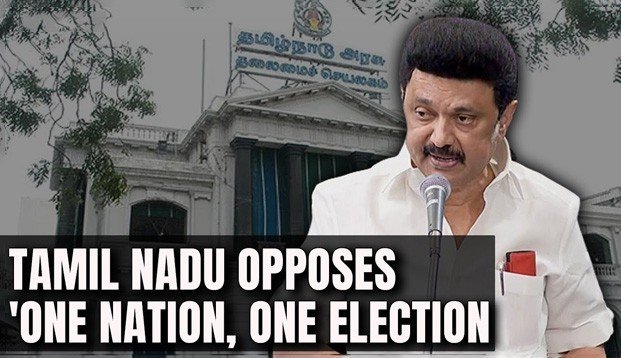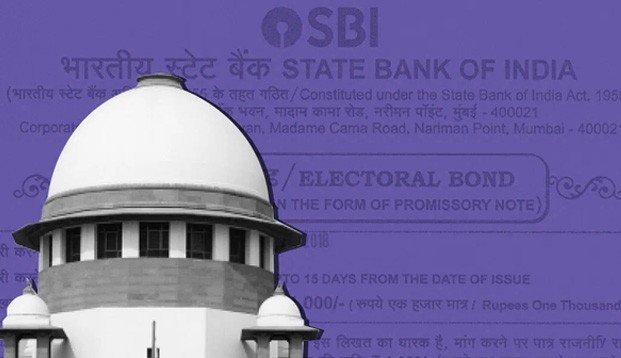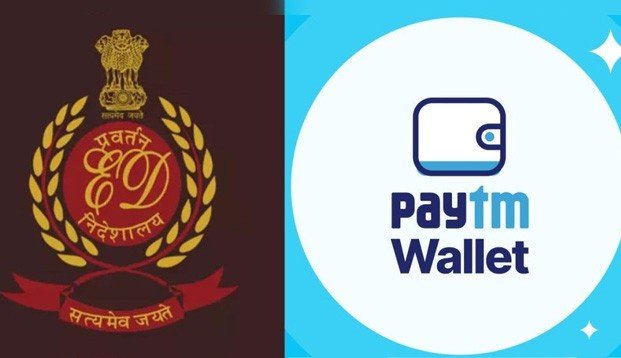15th February, 2024 (Thursday)
| CONTENT LIST | ||
| Topics | Syllabus | |
| 1 | One Nation, One Election | GS.2: Indian Polity – Election Reforms in India |
| 2 | Electoral Bond Scheme | GS. 2: Governance – Electoral Funding |
| 3 | Foreign Exchange Management Act, 1999 | GS.2: Corporate Governance |
| 4 | 16th Finance Commission | GS.2: Indian Polity: Fiscal Federalism |
| 5 | Supreme Court Collegium | GS. 2: Indian Polity – Judicial Appointment |
| 6 | India-UAE Cultural Diplomacy | GS.2: IR: India & West Asia (Mains) |
| 7 | Employees’ Provident Fund Organisation | GS.2: Social Justice: Pension Regulatory Bodies |
ONE NATION, ONE ELECTION
Syllabus: GS.2: Indian Polity – Election Reforms in India
Why it’s in the News: The Tamil Nadu Assembly unanimously adopted resolutions opposing the Union government’s ‘One nation, One Election’ proposal and the proposed delimitation after 2026.

Exploring One Nation, One Election: Streamlining India’s Electoral Process
- The government, led by Prime Minister Narendra Modi, has formed a committee chaired by former President Ram Nath Kovind to delve into the concept of ‘One Nation, One Election’, aiming to synchronize the Lok Sabha and state assembly elections.
- This initiative underscores the government’s commitment to overhaul the electoral system, as announced on September 1st, coinciding with Parliamentary Affairs Minister Pralhad Joshi’s declaration of a special parliamentary session scheduled for September 18-22, 2023.
About the ‘One Nation, One Election’:
- ‘One Nation, One Election’ proposes aligning the schedules of Lok Sabha and state assembly elections, potentially consolidating them into a single event.
- Prime Minister Modi has been a vocal advocate for this reform, emphasizing its efficiency and streamlining benefits, especially as India faces a series of impending elections, with assembly polls in five states followed closely by the Lok Sabha elections, projected for May-June 2024.
Pros of ‘One Nation, One Election’:
- Cost Reduction:
- Consolidating elections minimizes financial burdens associated with conducting separate polls.
- Administrative Efficiency:
- Simultaneous elections alleviate strain on administrative and security forces, optimizing resource utilization.
- Enhanced Governance Focus:
- Streamlined electoral cycles allow governments to prioritize governance over recurring election preparations, facilitating policy implementation.
- Increased Voter Turnout:
- According to the Law Commission, synchronized elections may boost voter participation by offering convenience and simplicity, potentially raising overall turnout rates.
Cons of ‘One Nation, One Election’:
- Constitutional Amendments:
- Implementation of ‘One Nation, One Election’ necessitates constitutional and legal revisions, involving complex procedures and approvals from state assemblies.
- Potential Dilution of Regional Issues:
- Concerns arise regarding the overshadowing of local and regional concerns by national agendas, potentially skewing electoral outcomes at the state level.
- Political Consensus Challenges:
- Achieving consensus among diverse political parties remains a formidable obstacle, with several opposition parties voicing reservations and opposition towards the initiative.
- This succinct overview delineates the key aspects, advantages, and challenges associated with the ‘One Nation, One Election’ proposal, underscoring its potential to reshape India’s electoral landscape while highlighting the complexities inherent in its implementation.
| NEWS PLUS: About Resolution A resolution can be moved by a member or Minister on a matter of general public interest. While there is no fixed day allotted for moving a resolution by a Minister, a private member can move a resolution only on an allotted day.Types of Resolutions: Private Members’ Resolutions: Moved by private members with a two-day notice.Non-binding; implementation is at the government’s discretion. Government Resolutions: Ministers give advance notice, published in the Bulletin.Time for discussion allocated by the House.Categories include treaties, policies, committee recommendations, and arbitration awards. Statutory Resolutions: Tabled as per Constitution or Acts.Notice by Minister or private member.Published in the Bulletin under ‘Statutory Resolution’ |
ELECTORAL BONDS SCHEME
Syllabus: GS. 2: Governance – Electoral Funding
Why it’s in the News: The Supreme Court to deliver verdict on Electoral Bond Scheme

What are Electoral Bonds?
- Electoral bonds are interest-free bearer bonds or financial instruments purchasable by companies and individuals in India from authorized branches of the State Bank of India (SBI).
- These bonds are issued in various denominations ranging from Rs 1,000 to Rs 1 crore and serve as a means for making donations to political parties.
How do Electoral Bonds Work?
- Electoral bonds can be purchased through a KYC-compliant account and are to be encashed by political parties within a specified time frame.
- The anonymity of donors is maintained as their information is not entered on the instrument.
- There are no limits on the quantity of electoral bonds that can be purchased by individuals or companies.
Government Amendments and Introduction
- The Electoral Bond Scheme was introduced through amendments to four Acts via the Finance Act of 2016 and 2017, including the Representation of the People Act, 1951, the Companies Act, 2013, the Income Tax Act, 1961, and the Foreign Contributions Regulation Act, 2010.
Eligibility and Procedures for Political Parties
- Political parties meeting certain criteria, such as securing at least 1% of the votes polled in recent elections and being registered under the RPA, can receive funding via electoral bonds.
- The bonds are to be deposited in verified accounts within 15 days of purchase, and the amounts received are then encashed and deposited into designated funds.
Concerns Regarding the Electoral Bond Scheme:
- Undermining Transparency: Critics argue that instead of promoting transparency in election funding, the electoral bond scheme does the opposite by allowing anonymity that primarily benefits the ruling party and larger corporations.
- Potential for Government Extortion: The sale of electoral bonds through a government-owned bank raises concerns about the government accessing information on donors, potentially leading to extortion or victimization of companies not supporting the ruling party.
- Democratic Principles Compromised: Exempting political parties from disclosing donations received through electoral bonds undermines the democratic principle of transparency, denying citizens crucial information for informed decision-making.
- Favoritism towards Corporate: The scheme facilitates unlimited corporate donations with significant tax exemptions, benefiting wealthy corporations and potentially distorting democratic processes.
- Legal Challenges: Amendments to the Finance Acts, particularly the Finance Act of 2017, have faced legal challenges for being unconstitutional and violating fundamental rights, including the right to freedom of expression.
- Threat to Free and Fair Elections: The lack of transparency in electoral funding, combined with government access to donor details, raises concerns about potential disruptions to free and fair elections by leveraging donor data for political advantage.
- Risk of Crony Capitalism: Removal of pre-existing limits on political donations creates opportunities for crony capitalism, allowing corporations to influence elections and establish mutually beneficial relationships with government officials, undermining democratic integrity.
Conclusion
- The Electoral Bond Scheme continues to be a subject of intense scrutiny and debate, with proponents arguing for its efficacy in promoting transparency and critics raising concerns about its potential to undermine democratic processes and foster corruption.
- The ongoing legal proceedings in the Supreme Court will likely shape the future trajectory of electoral financing in India.
FOREIGN EXCHANGE MANAGEMENT ACT (FEMA), 1999
Syllabus: GS.2: Corporate Governance
Why it’s in the News: The Enforcement Directorate (ED) had initiated a preliminary inquiry on Wednesday against Paytm for alleged FEMA violations.

About Foreign Exchange Management Act (FEMA):
- FEMA, enacted in 1999, governs cross-border trade and payments, replacing the Foreign Exchange Regulation Act (FERA).
- Key Provisions:
- Defines procedures for foreign exchange transactions in India.
- Overseen by the Enforcement Directorate in Delhi.
- Objectives:
- Facilitate External Trade and Payments: FEMA aims to streamline trade and payments processes in India.
- Ensure Market Development: It promotes orderly growth in the foreign exchange market.
- Regulate Capital Transactions: RBI can impose restrictions on capital account transactions.
- Applicability:
- Enforced nationwide, including Indian offices abroad.
- Applicable to Indian citizens, NRIs, overseas companies with 60% NRI ownership, and Indian corporate entities.
- Covers exports, imports, financial services, and cross-border transactions.
- Conclusion:
- FEMA serves as a comprehensive framework to regulate foreign exchange transactions, ensuring compliance and facilitating international trade.
16TH FINANCE COMMISSION
Syllabus: GS.2: Indian Polity: Fiscal Federalism
Why it’s in the News: Led by former NITI Aayog Vice-Chairman Arvind Panagariya, the 16th Finance Commission held its inaugural meeting in the capital to discuss terms of reference and engage stakeholders.

About Finance Commission:
- Established under Article 280 of the Indian Constitution, the Finance Commission is a constitutional body tasked with recommending financial resource allocations between the central government and state governments.
- The Fifteenth Finance Commission
- Established on November 27, 2017, the 15th Finance Commission (headed by Shri. N.K. Singh) provided recommendations for the period starting April 1, 2020, until the financial year 2025-26.
- Its recommendations are valid until the financial year 2025-26.
- Key Recommendations of 15th Finance Commission:
- The Commission proposed maintaining states’ share in central taxes at 41% for 2021-26, accommodating Jammu and Kashmir and Ladakh.
- It recommended limiting the Centre’s fiscal deficit to 4% of GDP by 2025-26 and specific fiscal deficit limits for states as a percentage of GSDP within 2021-26, with access to unutilized borrowing limits in subsequent years.
- Constitution of the Sixteenth Finance Commission
- Following Article 280(1) of the Constitution, the Government of India established the Sixteenth Finance Commission with Dr. Arvind Panagariya appointed as its Chairperson.
- Tasked with recommending a tax-sharing formula for the five-year period starting April 2026, the commission must submit recommendations by October 31, 2025.
SUPREME COURT COLLEGIUM
Syllabus: GS. 2: Indian Polity – Judicial Appointment
Why it’s in the News: India and EFTA countries consider reviving Trade and Economic Partnership Agreement (TEPA) negotiations. Leaked draft suggests potential delay in generic drug access by six years.
About Collegium System
- The Collegium system stands as a cornerstone for the appointment and transfer of judges within the Indian Supreme Court and High Courts.
- This mechanism operates with distinct characteristics and processes:
- Constitutional Foundation:
- The Collegium system, though not explicitly enshrined in the Constitution, has gained prominence through judicial interpretations and rulings of the Supreme Court.
- Composition:
- In the Supreme Court, the Collegium comprises the Chief Justice of India (CJI) and the four most senior judges of the court.
- At the High Court level, the Collegium is led by the Chief Justice of the respective High Court and the two senior-most judges.
- Recommendations and Appointments:
- The Collegium is primarily responsible for recommending suitable candidates for judicial appointments and transfers.
- Recommendations from the Collegium hold significant weight, and the government is generally expected to act upon them.
- Government Oversight:
- While the government retains the authority to raise objections or seek clarifications regarding the Collegium’s choices, it is obliged to appoint the recommended judges if the Collegium reaffirms its selections.
- Evolution of the Collegium System
- The Collegium system has undergone significant evolution over the years, shaped by key judicial pronouncements and legal developments:
- First Judges Case (1981):
- Established the primacy of the Chief Justice of India’s recommendations, albeit subject to “cogent reasons” by the Executive.
- Second Judges Case (1993):
- Introduces the Collegium system, emphasizing that consultation with the Chief Justice really implies concurrence.
- It highlights that the opinion expressed by the Chief Justice is institutional, representing collective deliberation with the two most senior judges.
- Third Judges Case (1998):
- Expanded the Collegium to a five-member body, including the CJI and four senior-most judges, in response to a presidential reference under Article 143.
- Fourth Judges Case (2015):
- Attempted reforms through the 99th Constitutional Amendment Act and the National Judicial Appointments Commission (NJAC) Act, aimed at replacing the Collegium system.
- However, the Supreme Court, in the fourth judges’ case, declared both the Amendment and the NJAC Act unconstitutional, reinstating the Collegium system.
- Through these legal milestones, the Collegium system has solidified its role as a crucial mechanism for ensuring the independence and integrity of the Indian judiciary.
INDIA-UAE CULTURAL DIPLOMACY
Syllabus: GS.2: IR: India & West Asia (Mains)
Why it’s in the News: Prime Minister Narendra Modi’s inauguration of Abu Dhabi’s inaugural Hindu stone temple marks a significant milestone in the cultural ties between India and the UAE.
About India-UAE Cultural Diplomacy
- Shared Heritage and Cultural Exchange:
- Symbol of Shared Heritage:
- The temple, built by the Bochasanwasi Akshar Purushottam Swaminarayan Sanstha (BAPS), underscores the deep-rooted cultural ties between India and the UAE.
- Mutual Respect and Gratitude:
- Prime Minister Modi expressed gratitude to UAE President Sheikh Mohammad Zayed Al Nahyan, highlighting his role in fostering goodwill among Indian expatriates and the broader Indian populace.
- Symbol of Shared Heritage:
- Promotion of Communal Harmony and Global Unity:
- Beyond Religious Boundaries:
- Mr. Modi emphasized the temple’s potential to promote communal harmony and global unity, transcending religious boundaries.
- Cultural Significance:
- The temple stands as a beacon of cultural exchange, fostering mutual understanding and respect between nations.
- Beyond Religious Boundaries:
- Evolution of UAE’s Identity:
- Cultural Diversity:
- Situated alongside prominent landmarks like the Burj Khalifa and Sheikh Zayed Mosque, the temple reflects the UAE’s evolving identity as a hub of cultural diversity and inclusivity.
- Cultural Chapter:
- Mr. Modi highlighted the UAE’s addition of another cultural chapter to its identity, beyond its renowned technological advancements and architectural marvels.
- Cultural Diversity:
- Bilateral Ties and Diplomatic Significance:
- Bilateral Cooperation:
- The inauguration strengthens bilateral ties and showcases the power of cultural diplomacy in fostering mutual understanding and goodwill.
- People-to-People Exchanges:
- The event paves the way for enhanced cooperation and collaboration in cultural exchanges, religious interactions, and people-to-people ties between India and the UAE.
- Bilateral Cooperation:
- Conclusion:
- The inauguration of Abu Dhabi’s first Hindu stone temple by Prime Minister Modi serves as a testament to the deep-rooted cultural connections between India and the UAE.
- Beyond religious boundaries, this event underscores the importance of cultural diplomacy in strengthening bilateral ties and fostering global unity.
- It symbolizes a new chapter in India – UAE relations, characterized by mutual respect, understanding, and cooperation in the cultural sphere.
EMPLOYEES’ PROVIDENT FUND ORGANISATION (EPFO)
Syllabus: GS.2: Social Justice: Pension Regulatory Bodies
Why it’s in the News: Pension concerns persist as EPFO recommends a 0.1% increase in PF deposits for 2023-24. Despite the record transfer of ₹1, 07,000 crore to EPF members, demands for a minimum pension hike to ₹3,000 remain unmet. Finance Ministry cites budgetary strain, but EPFO’s annual report challenges this, suggesting a doubling of minimum pension poses no significant burden.
About the Employees’ Provident Fund Organisation (EPFO)
- The Employees’ Provident Fund Organisation (EPFO) stands as a significant statutory body in India’s organized sector, providing essential financial security measures for employees.
- Establishment and Statutory Framework:
- Origins: Established under the Employees’ Provident Fund and Miscellaneous Provisions Act of 1952.
- Tri-partite Board: Administration is overseen by the Central Board of Trustees, Employees’ Provident Fund, comprising representatives from the Government (both Central and State), Employers, and Employees.
- Core Functions and Responsibilities:
- Provident Fund, Pension, and Insurance Schemes:
- Administers contributory provident fund, pension scheme, and insurance scheme for the organized sector workforce in India.
- Offers financial security measures like provident fund accumulation, pension benefits, and insurance coverage.
- Scale and Reach:
- EPFO ranks among the largest organizations globally, serving a vast clientele and processing significant financial transactions.
- Operates through 122 offices spread across the country to ensure widespread coverage and accessibility.
- Administrative Oversight:
- Under the administrative control of the Ministry of Labour and Employment, Government of India, ensuring compliance with statutory regulations and policies.
- Provident Fund, Pension, and Insurance Schemes:
- Key Schemes and Features:
- Employees’ Provident Funds Scheme 1952 (EPF):
- Features accumulation plus interest upon retirement and death.
- Allows partial withdrawals for specific purposes like education, marriage, illness, and house construction.
- Promotes housing schemes to fulfill the Prime Minister’s vision of Housing for All by 2022.
- Employees’ Pension Scheme 1995 (EPS):
- Provides monthly benefits for superannuation, disability, survivor, widow(er), and children.
- Ensures a minimum pension for disablement and offers past service benefits to participants of the erstwhile Family Pension Scheme, 1971.
- Employees’ Deposit Linked Insurance Scheme 1976 (EDLI):
- Offers benefits in case of an employee’s death who was a member of the scheme at the time of death.
- The benefit amount is 20 times the wages, with a maximum benefit of 6 Lakh.
- Employees’ Provident Funds Scheme 1952 (EPF):
- Conclusion:
- The Employees’ Provident Fund Organisation (EPFO) plays a pivotal role in safeguarding the financial well-being of employees in India’s organized sector.
- Through its comprehensive schemes and wide-reaching infrastructure, it ensures that employees have access to essential financial security measures such as provident funds, pensions, and insurance coverage.
- With its commitment to serving the workforce and promoting social security, EPFO continues to be a cornerstone of India’s labor welfare framework.


